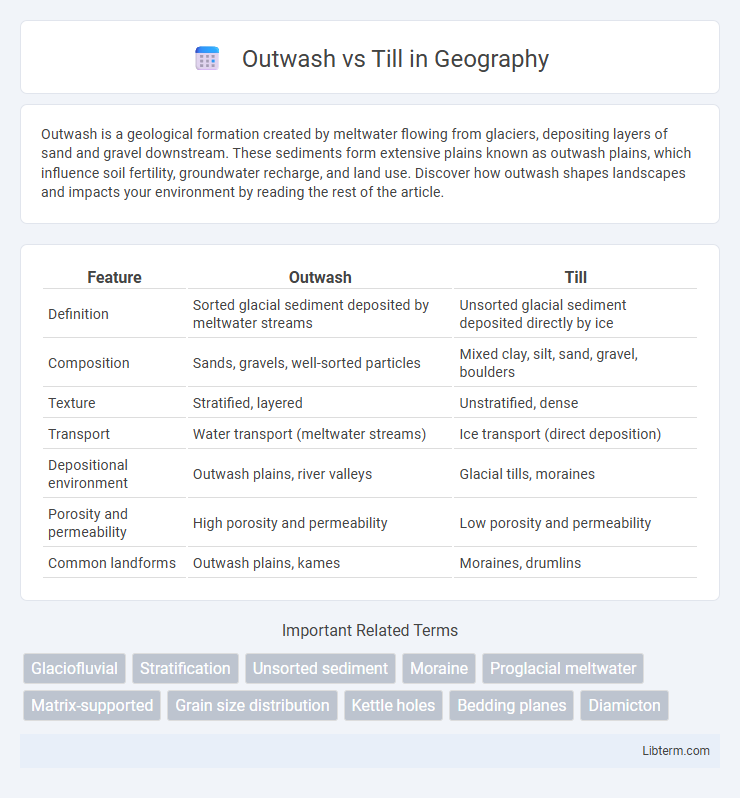Outwash is a geological formation created by meltwater flowing from glaciers, depositing layers of sand and gravel downstream. These sediments form extensive plains known as outwash plains, which influence soil fertility, groundwater recharge, and land use. Discover how outwash shapes landscapes and impacts your environment by reading the rest of the article.
Table of Comparison
| Feature | Outwash | Till |
|---|---|---|
| Definition | Sorted glacial sediment deposited by meltwater streams | Unsorted glacial sediment deposited directly by ice |
| Composition | Sands, gravels, well-sorted particles | Mixed clay, silt, sand, gravel, boulders |
| Texture | Stratified, layered | Unstratified, dense |
| Transport | Water transport (meltwater streams) | Ice transport (direct deposition) |
| Depositional environment | Outwash plains, river valleys | Glacial tills, moraines |
| Porosity and permeability | High porosity and permeability | Low porosity and permeability |
| Common landforms | Outwash plains, kames | Moraines, drumlins |
Introduction to Glacial Sediments
Outwash and till are two primary types of glacial sediments, each formed by distinct processes. Outwash consists of well-sorted, stratified sediments deposited by meltwater streams flowing from glaciers, typically composed of sand and gravel. Till is an unsorted, unstratified mixture of clay, silt, sand, gravel, and boulders directly deposited by glacial ice, reflecting the ice's ability to transport a wide range of sediment sizes.
Defining Outwash: Characteristics and Formation
Outwash refers to sediments deposited by meltwater from glaciers, characterized by well-sorted sands and gravels that create stratified layers due to water flow. This formation occurs in outwash plains or valleys, where glacial meltwater transports and deposits materials downstream, resulting in porous and permeable sediments. Unlike till, outwash sediments display clear stratification and sorting, lacking the unsorted, angular mixture of clay, silt, sand, and boulders typical of till deposits.
Understanding Till: Composition and Deposition
Till is an unsorted glacial sediment composed of a mixture of clay, sand, gravel, and boulders deposited directly by glacial ice. Unlike outwash, which is sorted and stratified by meltwater, till exhibits a heterogeneous texture due to its direct ice deposition without water reworking. Understanding till's composition and deposition helps reconstruct past glacial environments and distinguishes it from other glacial sediments in geological studies.
Key Differences Between Outwash and Till
Outwash consists of well-sorted sand and gravel deposits formed by meltwater streams from glaciers, resulting in stratified and permeable sediment layers. Till is an unsorted, unstratified mixture of clay, silt, sand, gravel, and boulders directly deposited by glacial ice, characterized by its heterogeneous texture and poor permeability. The key differences between outwash and till include their sorting, stratification, and mode of deposition, with outwash being sorted and layered due to water transport, while till is unstratified and deposited directly by ice.
Texture and Sorting: Outwash vs. Till
Outwash deposits exhibit well-sorted sand and gravel textures due to water transport, resulting in uniform grain sizes and distinct layering. In contrast, till is characterized by poorly sorted, unstratified mixtures of clay, silt, sand, gravel, and boulders directly deposited by glacial ice. The sorting difference is a key factor in distinguishing outwash plains, which are permeable and porous, from the dense, compact, and heterogeneous nature of till.
Effects on Soil and Landscape Formation
Outwash deposits, primarily composed of well-sorted sand and gravel, create highly permeable soils that promote efficient drainage and support diverse vegetation, shaping gently rolling landscapes. In contrast, till consists of unsorted clay, silt, sand, and boulders directly deposited by glaciers, resulting in dense, compacted soils with poor drainage that form irregular terrain featuring drumlins and moraines. These distinct sediment characteristics directly influence soil fertility, water retention, and topographic variation in glacially affected regions.
Environmental and Geological Significance
Outwash deposits, formed by meltwater from glaciers, consist mainly of well-sorted sand and gravel, playing a crucial role in groundwater recharge and aquifer formation due to their high permeability. Till, an unsorted mixture of clay, silt, sand, and boulders directly deposited by glacial ice, significantly influences soil fertility and landscape stability by providing a heterogeneous substrate that affects vegetation growth and erosion patterns. The contrasting properties of outwash and till impact sediment transport, water filtration, and ecosystem development, shaping the environmental and geological dynamics of glaciated regions.
Identification in the Field: Outwash and Till
Outwash is identified in the field by its well-sorted, stratified sand and gravel deposits typically found in braided stream channels, displaying clear layering and absence of fine clay particles. Till appears as a heterogeneous, unsorted mixture of clay, silt, sand, gravel, and boulders with no visible stratification, often forming dense, compacted lodgment till or loose, ablation till in proximity to glacial margins. Field identification relies on texture, sorting, and stratification differences, with outwash showing sediment transport by meltwater and till representing direct glacial deposition.
Common Landforms Associated with Each
Outwash deposits commonly form broad, flat plains known as outwash plains or sandurs, characterized by well-sorted sediments from glacial meltwater streams. Till, an unsorted mixture of clay, sand, gravel, and boulders, frequently creates moraines--ridges of accumulated debris marking past glacier margins. Eskers, typically associated with outwash, are sinuous ridges formed by sediment deposition in subglacial meltwater tunnels, whereas kames, irregular mounds of sand and gravel, can form from till deposits.
Summary: Choosing Outwash or Till in Studies
Outwash and till represent distinct glacial deposits influencing soil composition and groundwater flow in environmental and geological studies. Outwash, composed of well-sorted sands and gravels, facilitates higher permeability and is preferred in hydrogeological investigations requiring rapid water movement analysis. In contrast, till consists of unsorted, compacted sediments, often used in studies emphasizing sediment stability and soil mechanics due to its lower permeability and mixed grain size.
Outwash Infographic

 libterm.com
libterm.com